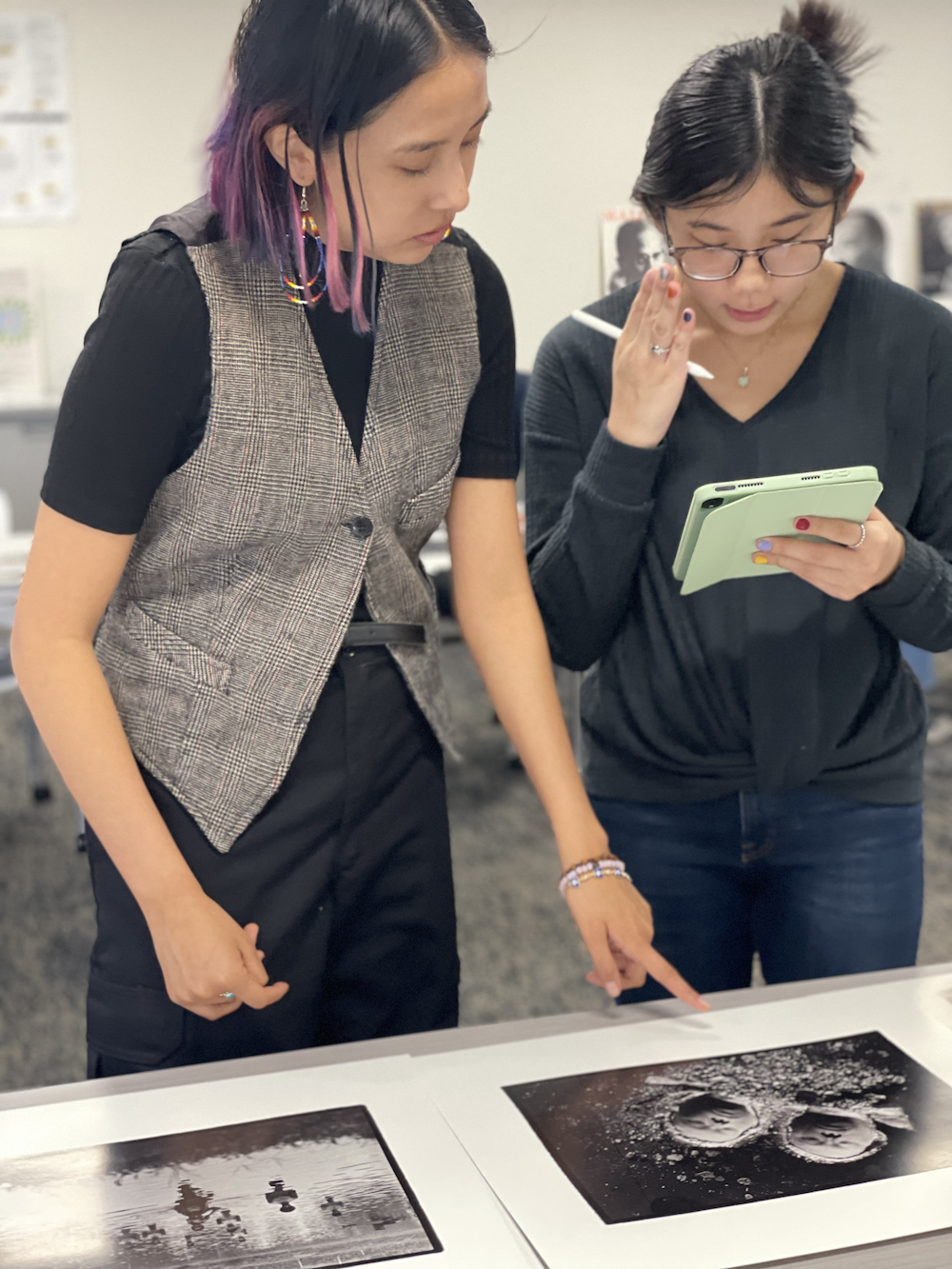Campus Collections

Looking Closely
A cornerstone of Art History is the close investigation of objects. At Bowdoin, students learn how to look closely to gather insights into an object’s visual and material dimensions, spatial effects, and techniques of production. Using the architecture of the campus, holdings of the Museum of Art, Arctic Museum, and other campus collections, Art History students engage deeply with actual objects through deliberate and extended examination.
Curating Connections
What happens when you collect objects together for an exhibition? What productive connections and narrative tensions are generated through their display and arrangement? Across our courses, students encounter curating as a critical practice for producing art histories.
Below are examples of exhibitions that have emerged out of Art History classes.
As a final assignment for her course Mannerism (spring 2022), Professor Susan Wegner asked students to propose possible themes for an exhibition on the artist Pontormo. She knew that the Bowdoin College Museum of Art was planning to bring together two other monochrome paintings to accompany their own Apollo and Daphne. Ingrid Astley ’24 produced a paper that focused on objectification, gender, and agency in Pontormo’s work. In summer 2022, while interning at the BCMA, Astley had the opportunity to turn her coursework into what would eventually become Metamorphosis and Malice. As a student curator, Astley continued to work closely with Professor Wegner throughout 2023 to bring the exhibition into fruition.
New Views of the Middle Ages: Highlights from the Wyvern Collection
Drawing upon the generous loan of works of art from the Wyvern Collection, one of the most important active private collections of medieval art today, students have had the tremendous opportunity to engage in object-driven learning. Led by Professor Kathryn Gerry, students in the advanced seminar Medieval Art and the Modern Viewer: Building an Exhibition with the Wyvern Collection (fall 2019) contributed to research on objects central to the exhibition New Views of the Middle Ages: Highlights from the Wyvern Collection. For Professor Gerry’s introductory-level course Building a Virtual Exhibition: A ‘Hands-On’ Experience (fall 2020), students then created a website that offered virtual visitors a chance to experience these fantastic works of medieval art. Throughout the course, students explored a variety of new technologies and digital strategies drawn from the digital humanities and computer sciences, including 3D modelling, Augmented Reality (AR), and the International Image Interoperability Framework (IIIF) to research and present outstanding pieces of medieval art from the Wyvern Collection.
Shoot, Snap Instagram: A History of Photography
Students in Professor Dana Byrd's Shoot, Snap, Instagram: A History of Photography in America (spring 2016) curated an exhibition of the same title based on the photographic holdings of the College’s George J. Mitchell Department of Special Collections & Archives (SC&A). Working closely with Marieke Van Der Steenhoven, Special Collections Education and Outreach Librarian, students engaged in the archive while learning about curatorial processes. The sixteen students each took charge of a theme and display that opened on the second floor gallery of the Hawthorne-Longfellow Library.
Sosaku-hanga: Twentieth-century Japanese Creative Prints
Curated by Professor Alison Miller and students in her advanced seminar Japanese Print Culture (fall 2016), Sosaku-hanga drew from the Bowdoin College Museum of Art’s collection twentieth-century Japanese creative prints. Throughout the course, students selected pieces to research, wrote labels on their objects, and discussed exhibition design. The exhibition was included as part of the museum’s larger exhibition Art & Resolution, 1900 to Today.
Beautiful Monstrosities, Elegant Distortions: The Artifice of Sixteenth-century Mannerism
Led by Professor Susan Wegner, students in Mannerism (spring 2016) curated Beautiful Monstrosities for the Bowdoin College Museum of Art. The exhibition examined the works of artists employed by European courts in the sixteenth century, such as the Medici in Florence, French royalty at Fontainebleau, and the Holy Roman Imperial courts in Vienna and Prague. Presenting their findings from the course, students showcased how artists of the sixteenth century catered to the refined tastes of the European nobility by inventing sublime distortions of the human body, allegorical monsters, and ornamental grotesques.
“Empire Follows Art”: Culture and Identity in the Atlantic World
Students in Professor Dana Byrd's course Sugar, Tobacco, Rice, and Rum: Identity and Culture in the Atlantic World (spring 2015) organized an exhibition at the Bowdoin College Museum of Art that highlighted the experience of the Atlantic World through art and artifacts. From gallery layouts to labels, creative student curators demonstrated that objects drawn from the collection could shed light on the development of economic, social, and intellectual ties among Europe, Africa, and America.
Fifty Years Later: The Portrayal of the Negro in American Painting (a digital exhibition)
In Professor Dana Byrd’s advanced seminar, Race and Representation in Visual Art, 1620-1976 (spring 2014), students examined a critical piece of Bowdoin history: the 1964 exhibition The Portrayal of the Negro in American Painting that was held at Bowdoin College during the height of the Civil Rights movement. Students’ final research papers—which addressed aspects of the show and its afterlife—serve as the basis of the on-line exhibition Fifty Years Later. In addition to concise versions of their longer seminar paper, each student also completed provenance research on the eighty paintings exhibited in 1964.
“We Never See Anything Clearly”: John Ruskin and Landscape Painting
Students in Professor Pamela Fletcher’s advanced seminar The Pre-Raphaelites researched and organized this exhibition focusing on John Ruskin (1819–1900), a prominent English art critic of the Victorian era and English and American artworks drawn from the Bowdoin College Museum of Art’s permanent collection. Professor Fletcher revisited a key artwork of the exhibition, William Henry Hunt’s Fungi, in a 2021 episode of Art Up Close for the museum.